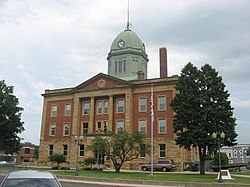2020 census
As of the 2020 census, the county had a population of 14,526. The median age was 41.1 years, 24.7% of residents were under the age of 18, and 20.9% were 65 years of age or older. For every 100 females there were 96.2 males, and for every 100 females age 18 and over there were 92.8 males age 18 and over. [12]
The racial makeup of the county was 95.1% White, 0.6% Black or African American, 0.2% American Indian and Alaska Native, 0.3% Asian, <0.1% Native Hawaiian and Pacific Islander, 0.6% from some other race, and 3.2% from two or more races. Hispanic or Latino residents of any race comprised 1.3% of the population. [13]
30.4% of residents lived in urban areas, while 69.6% lived in rural areas. [14]
There were 5,662 households in the county, of which 29.6% had children under the age of 18 living in them. Of all households, 54.8% were married-couple households, 16.1% were households with a male householder and no spouse or partner present, and 23.6% were households with a female householder and no spouse or partner present. About 27.1% of all households were made up of individuals and 13.3% had someone living alone who was 65 years of age or older. [12]
There were 6,159 housing units, of which 8.1% were vacant. Among occupied housing units, 75.6% were owner-occupied and 24.4% were renter-occupied. The homeowner vacancy rate was 2.1% and the rental vacancy rate was 7.5%. [12]
2010 census
As of the 2010 United States census, there were 14,846 people, 5,758 households, and 4,053 families living in the county. [24] The population density was 44.2 inhabitants per square mile (17.1/km2). There were 6,260 housing units at an average density of 18.6 per square mile (7.2/km2). [4] The racial makeup of the county was 98.5% white, 0.3% black or African American, 0.2% Asian, 0.2% American Indian, 0.2% from other races, and 0.6% from two or more races. Those of Hispanic or Latino origin made up 0.9% of the population. [24] In terms of ancestry, 23.8% were German, 12.0% were Irish, 11.4% were American, and 10.9% were English. [25]
Of the 5,758 households, 31.8% had children under the age of 18 living with them, 57.6% were married couples living together, 8.9% had a female householder with no husband present, 29.6% were non-families, and 25.5% of all households were made up of individuals. The average household size was 2.51 and the average family size was 3.01. The median age was 40.3 years. [24]
The median income for a household in the county was $46,364 and the median income for a family was $54,494. Males had a median income of $42,581 versus $26,799 for females. The per capita income for the county was $22,954. About 6.2% of families and 11.0% of the population were below the poverty line, including 17.2% of those under age 18 and 6.7% of those age 65 or over. [26]






